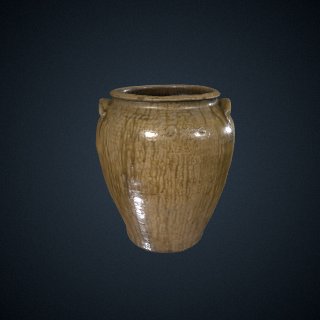Object Details
- Description
- This large alkaline-glazed stoneware jar was made in 1862 by David Drake, an enslaved black potter working on Lewis Miles’ plantation pottery in the Edgefield District of South Carolina. In a state that outlawed literacy among people who were enslaved, Dave defiantly proclaimed his ability to read and write by signing his name and sometimes inscribing poetry on the stoneware vessels he made.
- One of the most distinctive aspects of ante-bellum Edgefield was the presence of a large number of skilled people who were enslaved working as potters. Edgefield was one of only two areas in the United States known to have relied heavily on enslaved labor to manufacture utilitarian stoneware in large-scale potteries. Edgefield potteries furnished the large local plantations with the vessels needed for the preparation and storage of food for the planters and for the thousands of enslaved people working as agricultural and skilled laborers.
- While some of the enslaved people performed unskilled jobs in the potteries—such as digging and preparing clay and loading kilns—most were “turners,” performing the highly skilled work of forming ware on a potter’s wheel. At least 40 enslaved potters and pottery laborers are known to have worked in potteries in Edgefield between about 1815 and 1880. Some scholars believe over a hundred more may some day be identified.
- David Drake is the only enslaved potter known to have signed and dated his work. He was educated by his first enslaver, stoneware maker and newspaper editor Abner Landrum, and may have worked at Landrum’s newspaper, the Edgefield Hive, as a typesetter. When Landrum left the Edgefield area in 1831, Dave was sold to Lewis Miles, another large-scale pottery owner.
- Dave was a master potter, regularly producing massive storage jars and jugs that required enormous skill and strength. About twenty surviving Dave pieces are inscribed with Dave’s original two line poems—wonderful and sometimes cryptic ruminations on topics as diverse as pots, love, money, spirituality, life as a slave, and the afterlife. The poems reflect Dave’s intelligence, creativity, and wit.
- The poem on this jar, “I made this jar all of cross, If you don[’]t repent you will be lost,” may be a reference to the Bible, Acts 2: 14-42, Peter’s speech at Pentecost in the temple of Herod at Jerusalem. This jar, the last known poem piece, emphasizes the importance of religion and the afterlife in the daily life of many slaves. John Michael Vlach highlights this jar in The Afro-American Tradition in Decorative Arts, conjecturing that its “highly poignant verse” reflects "Dave’s combined feelings about slavery and religion.” On the reverse side, the jar is inscribed “May 3, 1862/ LM Dave.”
- Location
- Currently not on view
- date made
- 1862-05-03
- maker
- Drake, David
- Place Made
- United States: South Carolina, Lewis Miles Plantation
- Subject
- Slavery
- See more items in
- Home and Community Life: Ceramics and Glass
- Cultures & Communities
- National Treasures exhibit
- Religion
- Domestic Furnishings
- Related Publication
- Kendrick, Kathleen M. and Peter C. Liebhold. Smithsonian Treasures of American History
- National Museum of American History. Treasures of American History online exhibition
- Related Web Publication
- https://americanhistory.si.edu/explore/exhibitions/treasures-american-history
- Data Source
- National Museum of American History
- ID Number
- 1996.0344.01
- catalog number
- 1996.0344.01
- accession number
- 1996.0344
- Object Name
- jar
- Physical Description
- ceramic (overall material)
- stoneware (overall material)
- wheel thrown (overall production method/technique)
- Measurements
- average spatial: 20 1/2 in x 18 in; 52.07 cm x 45.72 cm
- Record ID
- nmah_1181785
- Metadata Usage
- CC0
Related Object Groups
Thanks to Verizon for support of this Our Shared Future: Reckoning with our Racial Past project.
This image is in the public domain (free of copyright restrictions). You can copy, modify, and distribute this work without contacting the Smithsonian. For more information, visit the Smithsonian's Open Access page.
Thanks to Verizon for support of this Our Shared Future: Reckoning with our Racial Past project.
We also suggest that users:
- Give attribution to the Smithsonian.
- Contribute back any modifications or improvements.
- Do not mislead others or misrepresent the datasets or its sources.
- Be responsible.
International media Interoperability Framework
IIIF provides researchers rich metadata and media viewing options for comparison of works across cultural heritage collections. Visit the IIIF page to learn more.

3D Model


